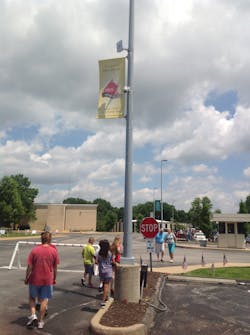Creating a successful video surveillance system has become very different than it was 10 years ago. Taking a backseat in the process is the traditional point-to-point analog surveillance system consisting of analog cameras transmitting over coaxial cable (coax), UTP or optical fiber. Traditional analog systems are very much in play and are still being specified and used very successfully; however, network or IP video is gaining significantly every year.
Whether you are planning an analog video CCTV or IP video network, here are some tips to consider when planning your video transmission system.
1. Choose the system that best meets your needs, whether it is analog or IP video.
Although IP is now on the leading edge, analog systems still work well, are cost-effective and easy to install. If you are recommending an analog system, what distances are you facing? For extended distances, fiber optic is a better choice. Instead of being limited to the accepted 750 -1000 feet distances that coax cable supports, fiber offers distances in kilometers and miles for multi-mode fiber; and larger numbers of miles and kilometers using single-mode fiber optic cables.
Media cost is very close, but optical fiber gives you the option of transmitting up to 32 channels of uncompressed full-motion, full-color, real-time video and eight channels of camera control data simultaneously on a single strand of single-mode optical fiber, at distances up to 35 miles.
Most CCTV projects are a fraction of that distance, but it gives you a perspective on the bandwidth available. Fiber optic video transmission allows for RS-232, RS-422 and RS-485 or “up-the-coax” camera control data and audio to be transmitted along with the video. It also gives you options regarding video quality and can easily transmit RS-250C Short-Haul quality; 10-bit digitally encoded video with no latency over these distances.
When you factor in the cost of fiber optic transmission vs. traditional coax or even UTP, it becomes an easy choice. Fiber Optic networks also give you many options in terms of system topology. In addition to point-to-point and star topologies, fiber optic networks can be designed as add, drop and repeat; and as closed-ring, redundant networks.
2. IP or Ethernet-based video transmission networks are becoming a greater focus as a solution to today’s video transmission challenges.
The move to IP video networks using IP cameras and network products has produced a significant technology shift. Technology continues to evolve and ever-improving advancements such as megapixel and cloud topologies have surfaced, and this has helped secure the demand for IP systems.
The advantages that a complete, networked solution gives you are significant. Ethernet is standards-based, so in theory, if you interconnect different manufacturers’ components, and transmit all types on signals over the same network — video, intercom, access control, data and more — everything should operate seamlessly. The flexibility in how you connect these edge and network components is also very attractive.
Scalability is also very important and you can easily add on additional edge components at a much less expensive rate much more easily. The network itself has incredible intelligence for self-monitoring, redundancy and optimization.
You now also have lots of intelligence pushed out to the edge of the network, enabling capabilities like analytics and systems monitoring that far exceed older abilities.
3. Encode, rip-and-replace or retrofit?
Once the decision has been made to move to an IP CCTV Network, you are faced with a few options regarding video transmission. If the move is in a current facility with an existing analog CCTV System, you must:
- Encode the existing analog video;
- Start over completely; or
- Retrofit existing equipment and media.
Encoding entails keeping the existing analog CCTV cameras and their corresponding media, be it coax, UTP or Fiber Optic and, using a video encoder/decoder, converting the video to Ethernet and inserting it onto the network through a network switch. The IP video is then directed to a network video recorder for monitoring and storage. Encoding is most likely the least expensive way to move to IP video. The encoding/decoding can be done at the remote location using video encoders or at the head-end, where the video can be transported over existing media and encoded before being inserted on to the network. Encoding at the remote location can be made with any of hundreds of video encoders available today. If the remote location is unconditioned, then a hardened encoder must be selected, and they are a little more difficult to find. The downside to encoding analog video is a limitation in video quality. As good as most analog cameras are, they are no match for today’s megapixel or high definition cameras.
Complete start over. A complete start over is likely the most costly, but is really the only way to truly future-proof your CCTV network. So, what do you need to be thinking about with respect to designing a network?
First, are you dropping cameras onto an existing network that you are using for normal company operations? That might not be the best planning, as IP video requires a lot of bandwidth. Disrupting or slowing down a company’s existing operational network might not be a prudent decision. Starting a new Ethernet network for security might be the safer bet in the long run.
When planning an IP Security network, for each location, you need to understand a current need for the number of devices, plus what you expect to need for expansion (vs. cost). You must also be able to determine and plan. Questions that will come up are:
- How much bandwidth will your devices need, across each segment and aggregated?
- What distances do you need to cover? The answer to this question determines what type of media you will need to select. For systems that use megapixel or HD IP cameras with distance considerations, single-mode fiber optic equipment is a safe choice.
- Are you using a Managed Ethernet Switch? A managed switch enables a user to control the IP address and features of the switch, giving the ability to precisely optimize and control traffic on the network; thus allowing the media to be used more efficiently. Using managed switches helps the chosen media — copper, fiber or wireless — to use the available bandwidth more efficiently.
Retrofit. Can I re-use existing cabling? If a fiber optic CCTV network is/was in place, chances are the fiber can be re-used with simple fiber optic media converters or switches with optical ports.
If the existing CCTV surveillance network is/was in place and the move to Ethernet is being made, IP video can be transported over the existing coax or UTP. Manufacturers can offer products that can extend distances over existing coax or UTP and support PoE. Using these products, you can transmit 100Mbps of Ethernet data to distances of approximately 600 meters without PoE or approximately 200-300 meters depending on IP camera power consumption with Class 3 13 watt PoE. There are variations to account for when using higher power, but these distances are good general recommendations. All these distances are greater than the 100-meter generally accepted maximum distance for fast Ethernet.
4. Is wireless the right choice?
Wireless Ethernet Transmission holds great potential, as it does not bind you to the logistics of running copper or fiber optic cables. It sounds simple, but there are many parameters that must be factored in to get a favorable installation. Network topology, obstacles, weather and time of year all have to be considered. But many wireless Ethernet product lines promise installation that is basically power, point and play — meaning you power up the access point and the field deployed client, point/aim the units using the antenna alignment tool and start transmitting Ethernet. Taking the complexity out of using wireless is a major advantage to acceptance and use. It is still not for every application, but it has its place.
5. Will the system operate seamlessly?
The promise of Ethernet and the entire IEE802.3 set of standards is to ensure that all IP devices that meet that standard theoretically operate seamlessly over the network. The reality of that promise is that many times, IP devices from different manufacturers do not seamlessly operate.
The safe bet for IP video transmission is to choose the transmission products from one manufacturer. If you can find a single source for your Ethernet transmission equipment, be it wireless Ethernet, Fiber Optic Ethernet, Ethernet over copper, Ethernet switches, media converters, having it all operate seamlessly is more likely to occur.
In many cases, working closely with the product manufacturer and supplying them or working with them on the system design will allow configuration testing to happen before the installation. Working closely with the manufacturer allows interoperability issues to be solved in the lab and not in the field.
Frank “Skip” Haight has been leading the marketing effort for high-profile communication product manufacturing companies for the past 14 years. Currently he is Vice President of Marketing for ComNet Communication Networks in Danbury, Conn. Request more information about ComNet at www.securityinfowatch.com/10215705.



